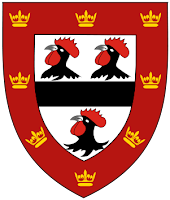This is all about a one day conference that was held here in Cambridge last Wednesday for a select group of people from sicence media, predominantly including journalists and film makers, all of whom have extensive and well developed online personas. Several of us from BlueSci where very honored to be asked to attend too, as the focus was squarely on the future. Where we at BlueSci, as aspiring science writers could take the field in the coming years.
The day was full of exciting and controversial bits of debate and we got to hear lots from many different view points about what science journalists should be doing and how we should be interacting with academics and the public. Here I have outlined the major topics discussed, more details are available elsewhere (see the end). Whilst I dod find some opinions difficult to agree with, it was interesting to hear what everyone had to say and I feel I have gained a lot from the experience.
Also I'll hopefully be posting again soon as following this conference I saw Simon Singh again, along with Ben Goldacre and Brian Cox on their Uncaged Monkeys tour here in Cambridge, so stay tuned for that.
 |
| The crest of Jesus College |
The day took the form of a series of open discussions with two leaders providing focus to the discussion. After a warm welcome by John Cornwell, John Naughton opened the first session by discussing the opportunities and challenges involved in adopting new media. He focused on how newspapers have become news organisations, with the paper being one of many media products. Science journalism was effectively compared to a developing ecology where a few large dinosaurs are being replaced by a myriad army of journalistic, blogging termites with a corresponding increase in productivity. The reduction is media size was also highlighted; people buy tracks not albums, read stories not papers and posts not blogs. He asked the questions: How do we add value to a story amidst such competition? And who pays for good journalism when so much of it is free online?
 |
| The first session of the conference. Science Journalism in the era of New Media |
 |
| Several delegates got rather enthusiastic showing the different media that they use to communicate. Media included facebook, twitter, blogging. |
 |
| Delegates socialising over drinks. |
Perhaps the biggest shock of the whole debate came when discussion was opened on the issue, met by silence across the floor. Nearly 50 science journalists had nothing to say on the matter of science and religion. It may be that everyone was unwilling to comment openly on such a complex subject, although several comments suggested that many feel there is simply nothing to discuss. Later conversations on the matter also revealed that many fail to see what the issue is, feeling that religion and science are separate and failing to see why we bother considering the two together. The session found that the issue is more science vs. stupidity which is often misdirected as science vs. religion. This session did spark a lot of online Twitter commentary, with the sentiment being rather rebellious, feeling that the discussion was not living up to the broader title.
 |
| Simon Singh leading his part of the session about Ethics in Science Media |
Adam Wishart’s dramatic documentaries were to focus of the latter part of the ethics discussion, which is often a complex issue in his work. He feels that we should be doing more to address the way in which public money is spent on medical causes. This issues was the focus of his recent work with highly premature babies, discussing whether it is more worthwhile to invest in extending the lives of the elderly or helping babies that are likely to require extensive investment throughout their lives. Much of Adam’s work is considered to be too dark and gritty by mainstream media. A lot of questions were asked about the intricacies of obtaining consent to film and broadcast footage for these hard hitting documentaries and when and how it is safe to do so. Adam’s honesty in discussing these issues was admirable.
 |
| The great hall of Jesus College, taken from the Minstrel's Gallery where tea and coffee were served. |
The event was live-tweeted by @bluesci with the tag #nextgen11, it has also been storified here and several other blog posts have been put together here.
No comments:
Post a Comment